考研英语语法十天速成超详细笔记
- 格式:doc
- 大小:3.34 MB
- 文档页数:12
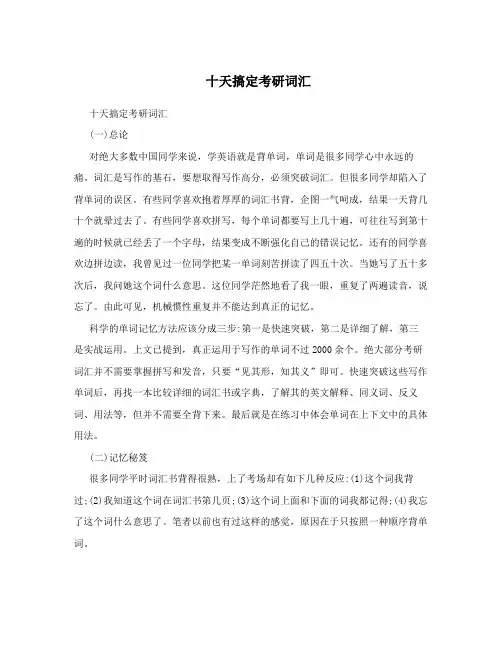
十天搞定考研词汇十天搞定考研词汇(一)总论对绝大多数中国同学来说,学英语就是背单词,单词是很多同学心中永远的痛。
词汇是写作的基石,要想取得写作高分,必须突破词汇。
但很多同学却陷入了背单词的误区。
有些同学喜欢抱着厚厚的词汇书背,企图一气呵成,结果一天背几十个就晕过去了。
有些同学喜欢拼写,每个单词都要写上几十遍,可往往写到第十遍的时候就已经丢了一个字母,结果变成不断强化自己的错误记忆。
还有的同学喜欢边拼边读,我曾见过一位同学把某一单词刻苦拼读了四五十次。
当她写了五十多次后,我问她这个词什么意思。
这位同学茫然地看了我一眼,重复了两遍读音,说忘了。
由此可见,机械惯性重复并不能达到真正的记忆。
科学的单词记忆方法应该分成三步:第一是快速突破,第二是详细了解,第三是实战运用。
上文已提到,真正运用于写作的单词不过2000余个。
绝大部分考研词汇并不需要掌握拼写和发音,只要“见其形,知其义”即可。
快速突破这些写作单词后,再找一本比较详细的词汇书或字典,了解其的英文解释、同义词、反义词、用法等,但并不需要全背下来。
最后就是在练习中体会单词在上下文中的具体用法。
(二)记忆秘笈很多同学平时词汇书背得很熟,上了考场却有如下几种反应:(1)这个词我背过;(2)我知道这个词在词汇书第几页;(3)这个词上面和下面的词我都记得;(4)我忘了这个词什么意思了。
笔者以前也有过这样的感觉,原因在于只按照一种顺序背单词。
背单词应该按照三种顺序:正序记忆、逆序记忆和乱序记忆。
绝大部分词汇书是按正序(即字母A~Z的顺序)编排的。
很多同学背A时信心百倍,背B时备受打击,背C时彻底崩溃,因此出现了很多C先生、D小姐。
书的A到C部分已经翻黑、翻烂了,而Z那个部分还从来没看过。
显然,这样是不行的。
第一遍背单词可以正序记忆,从第一页看到第十页。
第二遍背单词应该采用逆序记忆,从第十页最后一个单词倒着往前背。
从第三遍开始进行乱序记忆,从第五、八页等开始,先往前背,后往后背,这样才能建立对应关系,彻底记住单词。
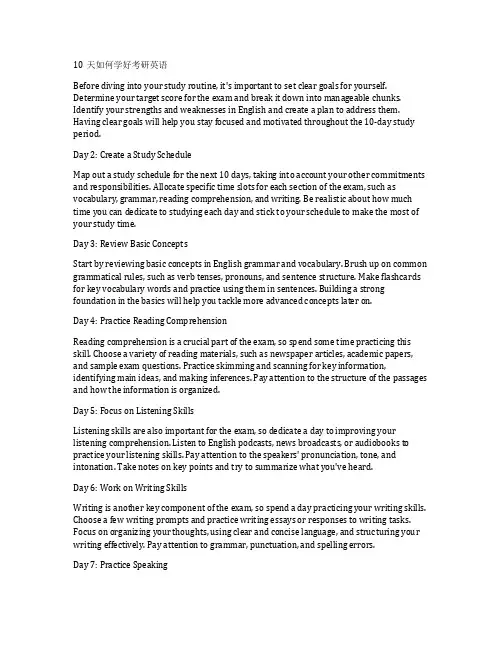
10天如何学好考研英语Before diving into your study routine, it's important to set clear goals for yourself. Determine your target score for the exam and break it down into manageable chunks. Identify your strengths and weaknesses in English and create a plan to address them. Having clear goals will help you stay focused and motivated throughout the 10-day study period.Day 2: Create a Study ScheduleMap out a study schedule for the next 10 days, taking into account your other commitments and responsibilities. Allocate specific time slots for each section of the exam, such as vocabulary, grammar, reading comprehension, and writing. Be realistic about how much time you can dedicate to studying each day and stick to your schedule to make the most of your study time.Day 3: Review Basic ConceptsStart by reviewing basic concepts in English grammar and vocabulary. Brush up on common grammatical rules, such as verb tenses, pronouns, and sentence structure. Make flashcards for key vocabulary words and practice using them in sentences. Building a strong foundation in the basics will help you tackle more advanced concepts later on.Day 4: Practice Reading ComprehensionReading comprehension is a crucial part of the exam, so spend some time practicing this skill. Choose a variety of reading materials, such as newspaper articles, academic papers, and sample exam questions. Practice skimming and scanning for key information, identifying main ideas, and making inferences. Pay attention to the structure of the passages and how the information is organized.Day 5: Focus on Listening SkillsListening skills are also important for the exam, so dedicate a day to improving your listening comprehension. Listen to English podcasts, news broadcasts, or audiobooks to practice your listening skills. Pay attention to the speakers' pronunciation, tone, and intonation. Take notes on key points and try to summarize what you've heard.Day 6: Work on Writing SkillsWriting is another key component of the exam, so spend a day practicing your writing skills. Choose a few writing prompts and practice writing essays or responses to writing tasks. Focus on organizing your thoughts, using clear and concise language, and structuring your writing effectively. Pay attention to grammar, punctuation, and spelling errors.Day 7: Practice SpeakingSpeaking skills are often overlooked in English exams, but they are crucial for effectively expressing your ideas. Practice speaking English aloud, either by yourself or with a study partner. Choose topics to discuss and practice expressing your opinions and ideas clearly and confidently. Pay attention to your pronunciation, fluency, and intonation.Day 8: Review Sample QuestionsTake some time to review sample questions from previous exams or practice tests. Familiarize yourself with the format of the exam, the types of questions asked, and the time constraints. Practice answering multiple-choice questions, reading comprehension passages, and writing tasks. Pay attention to common mistakes and areas where you need to improve.Day 9: Seek FeedbackSeek feedback from a teacher, tutor, or study partner to assess your progress so far. Ask for constructive criticism on your strengths and weaknesses in English and how you can improve. Take note of areas where you need to focus more attention and make adjustments to your study plan accordingly.Day 10: Final Review and RelaxationOn the final day before the exam, take some time to review key concepts and practice a few more sample questions. However, don't cram or overload your brain with information. Instead, focus on staying calm, relaxed, and confident in your abilities. Get plenty of rest, eat well, and stay hydrated to ensure you're in the best possible shape for the exam.By following this 10-day study plan, you can build a solid foundation in English and improve your chances of success in the exam. Remember to stay focused, motivated, and disciplined throughout the study period. Good luck!。

十天搞定考研词汇十天搞定考研词汇(一)总论对绝大多数中国同学来说,学英语就是背单词,单词是很多同学心中永远的痛。
词汇是写作的基石,要想取得写作高分,必须突破词汇。
但很多同学却陷入了背单词的误区。
有些同学喜欢抱着厚厚的词汇书背,企图一气呵成,结果一天背几十个就晕过去了。
有些同学喜欢拼写,每个单词都要写上几十遍,可往往写到第十遍的时候就已经丢了一个字母,结果变成不断强化自己的错误记忆。
还有的同学喜欢边拼边读,我曾见过一位同学把某一单词刻苦拼读了四五十次。
当她写了五十多次后,我问她这个词什么意思。
这位同学茫然地看了我一眼,重复了两遍读音,说忘了。
由此可见,机械惯性重复并不能达到真正的记忆。
科学的单词记忆方法应该分成三步:第一是快速突破,第二是详细了解,第三是实战运用。
上文已提到,真正运用于写作的单词不过2000余个。
绝大部分考研词汇并不需要掌握拼写和发音,只要“见其形,知其义”即可。
快速突破这些写作单词后,再找一本比较详细的词汇书或字典,了解其的英文解释、同义词、反义词、用法等,但并不需要全背下来。
最后就是在练习中体会单词在上下文中的具体用法。
(二)记忆秘笈很多同学平时词汇书背得很熟,上了考场却有如下几种反应:(1)这个词我背过;(2)我知道这个词在词汇书第几页;(3)这个词上面和下面的词我都记得;(4)我忘了这个词什么意思了。
笔者以前也有过这样的感觉,原因在于只按照一种顺序背单词。
背单词应该按照三种顺序:正序记忆、逆序记忆和乱序记忆。
绝大部分词汇书是按正序(即字母A~Z的顺序)编排的。
很多同学背A时信心百倍,背B时备受打击,背C时彻底崩溃,因此出现了很多C先生、D小姐。
书的A到C部分已经翻黑、翻烂了,而Z那个部分还从来没看过。
显然,这样是不行的。
第一遍背单词可以正序记忆,从第一页看到第十页。
第二遍背单词应该采用逆序记忆,从第十页最后一个单词倒着往前背。
从第三遍开始进行乱序记忆,从第五、八页等开始,先往前背,后往后背,这样才能建立对应关系,彻底记住单词。
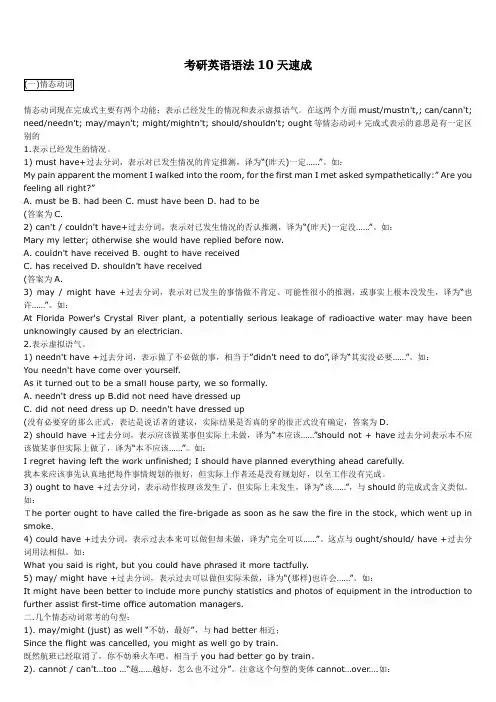
考研英语语法10天速成情态动词现在完成式主要有两个功能:表示已经发生的情况和表示虚拟语气。
在这两个方面must/mustn't,; can/cann't; need/needn't; may/mayn't; might/mightn't; should/shouldn't; ought等情态动词+完成式表示的意思是有一定区别的1.表示已经发生的情况。
1) must have+过去分词,表示对已发生情况的肯定推测,译为“(昨天)一定……”。
如:My pain apparent th e moment I walked into the room, for the first man I met asked sympathetically:” Are you feeling all right?”A. must beB. had beenC. must have beenD. had to be(答案为C.2) can't / couldn't have+过去分词,表示对已发生情况的否认推测,译为“(昨天)一定没……”。
如:Mary my letter; otherwise she would have replied before now.A. couldn't have receivedB. ought to have receivedC. has receivedD. shouldn't have received(答案为A.3) may / might have +过去分词,表示对已发生的事情做不肯定、可能性很小的推测,或事实上根本没发生,译为“也许……”。
如:At Florida Power's Crystal River plant, a potentially serious leakage of radioactive water may have been unknowingly caused by an electrician.2.表示虚拟语气。
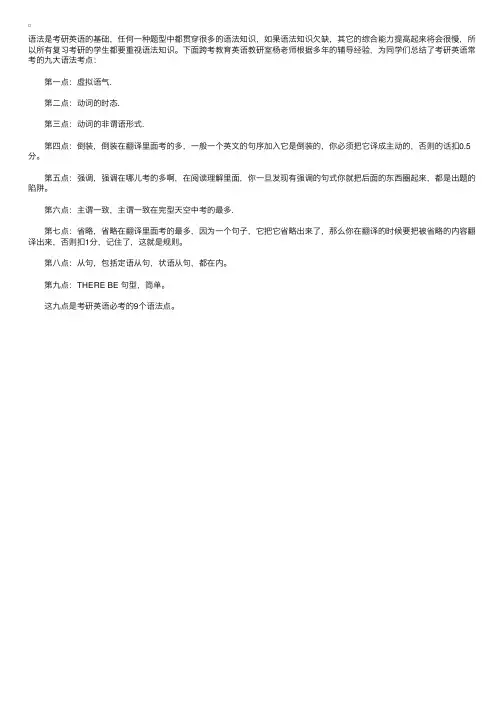
语法是考研英语的基础,任何⼀种题型中都贯穿很多的语法知识,如果语法知识⽋缺,其它的综合能⼒提⾼起来将会很慢,所以所有复习考研的学⽣都要重视语法知识。
下⾯跨考教育英语教研室杨⽼师根据多年的辅导经验,为同学们总结了考研英语常考的九⼤语法考点:
第⼀点:虚拟语⽓.
第⼆点:动词的时态.
第三点:动词的⾮谓语形式.
第四点:倒装,倒装在翻译⾥⾯考的多,⼀般⼀个英⽂的句序加⼊它是倒装的,你必须把它译成主动的,否则的话扣0.5分。
第五点:强调,强调在哪⼉考的多啊,在阅读理解⾥⾯,你⼀旦发现有强调的句式你就把后⾯的东西圈起来,都是出题的陷阱。
第六点:主谓⼀致,主谓⼀致在完型天空中考的最多.
第七点:省略,省略在翻译⾥⾯考的最多,因为⼀个句⼦,它把它省略出来了,那么你在翻译的时候要把被省略的内容翻译出来,否则扣1分,记住了,这就是规则。
第⼋点:从句,包括定语从句,状语从句,都在内。
第九点:THERE BE 句型,简单。
这九点是考研英语必考的9个语法点。
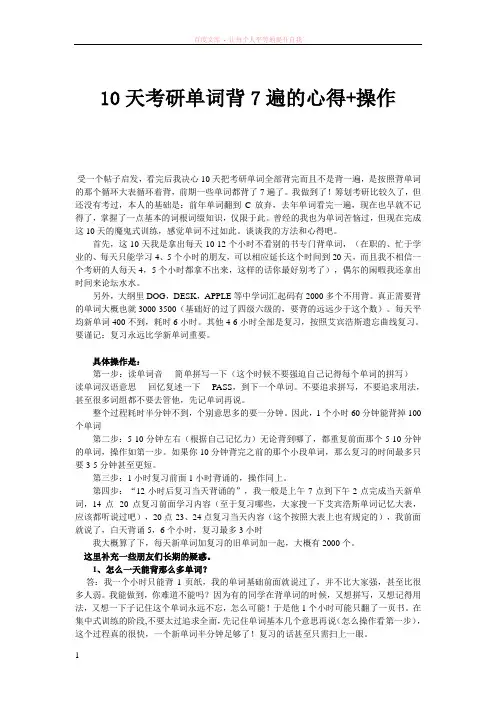
10天考研单词背7遍的心得+操作受一个帖子启发,看完后我决心10天把考研单词全部背完而且不是背一遍,是按照背单词的那个循环大表循环着背,前期一些单词都背了7遍了。
我做到了!筹划考研比较久了,但还没有考过,本人的基础是:前年单词翻到C放弃,去年单词看完一遍,现在也早就不记得了,掌握了一点基本的词根词缀知识,仅限于此。
曾经的我也为单词苦恼过,但现在完成这10天的魔鬼式训练,感觉单词不过如此。
谈谈我的方法和心得吧。
首先,这10天我是拿出每天10-12个小时不看别的书专门背单词,(在职的、忙于学业的、每天只能学习4、5个小时的朋友,可以相应延长这个时间到20天,而且我不相信一个考研的人每天4,5个小时都拿不出来,这样的话你最好别考了),偶尔的闲暇我还拿出时间来论坛水水。
另外,大纲里DOG,DESK,APPLE等中学词汇起码有2000多个不用背。
真正需要背的单词大概也就3000-3500(基础好的过了四级六级的,要背的远远少于这个数)。
每天平均新单词400不到,耗时6小时。
其他4-6小时全部是复习,按照艾宾浩斯遗忘曲线复习。
要谨记:复习永远比学新单词重要。
具体操作是:第一步:读单词音----简单拼写一下(这个时候不要强迫自己记得每个单词的拼写)---读单词汉语意思----回忆复述一下----PASS,到下一个单词。
不要追求拼写,不要追求用法,甚至很多词组都不要去管他,先记单词再说。
整个过程耗时半分钟不到,个别意思多的要一分钟。
因此,1个小时60分钟能背掉100个单词第二步:5-10分钟左右(根据自己记忆力)无论背到哪了,都重复前面那个5-10分钟的单词,操作如第一步。
如果你10分钟背完之前的那个小段单词,那么复习的时间最多只要3-5分钟甚至更短。
第三步:1小时复习前面1小时背诵的,操作同上。
第四步:“12小时后复习当天背诵的”,我一般是上午7点到下午2点完成当天新单词,14点--20点复习前面学习内容(至于复习哪些,大家搜一下艾宾浩斯单词记忆大表,应该都听说过吧),20点-23、24点复习当天内容(这个按照大表上也有规定的),我前面就说了,白天背诵5,6个小时,复习最多3小时我大概算了下,每天新单词加复习的旧单词加一起,大概有2000个。
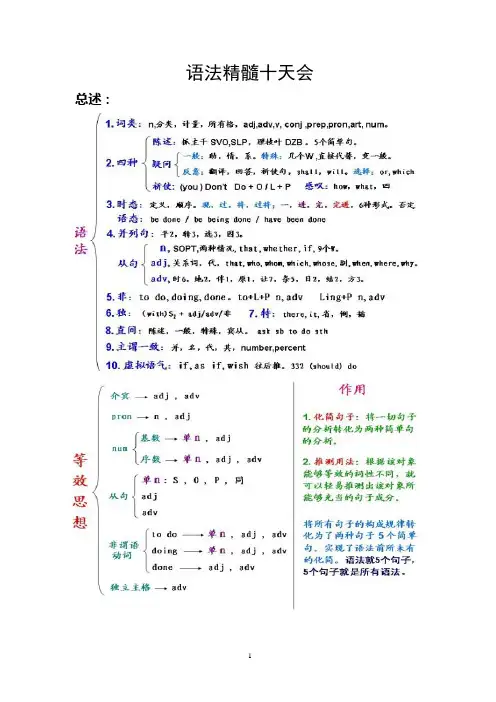
语法精髓十天会总述:如果句子包含两个或以上互不依从的意义相关、层次相同、句法功能也相同的主谓结构就是并列句。
并列句分句通常由并列连词来连接。
有时并列句中的分句通过一定的标点符号如逗号、分号等来表现这种并列关系。
例如:I turned on the TV and we sat down and watched it.我打开电视然后我们坐下看。
I help you and you help me. 我帮你,你帮我。
You may go with us, or you may stay at home today.今天你可以和我们一起去也可呆在家里。
上面的三个句子通过并列连词实现并列关系。
而下面的二个句子则通过标点来体现并列关系。
例如:It was getting late; we had to go back for the city.天逐渐晚了;我们得回到城市。
Stand up; it is your turn to speak now.站起来;现在轮到你发言了。
总的说来,英语中的并列连词的数量不多。
其中最主要、最典型的并列连词有and ,or和but。
除上述三个最常用的并列连词之外,还有几个并列关联连词,如both…and,either…or, not…but, neither…nor, not only…but also。
yet和so也可作并列连词使用。
并列连词中还有一类介乎于并列连词与从属连词或介词之间的一些词组如as well as, rather than,more than,as much as,也可作并列连词使用,它们也被称为‚边际并列连词‛。
并列连词and表示引申意义;or表示选择意义;but表示转折意义;这是常见的最典型的三个并列连词的基本差别。
例如:Give him an inch and he will take a yard.得寸进尺。
(给他一英寸他就会要一码。
)Get out of the house or I will beat you.滚出房子否则我会痛击你。
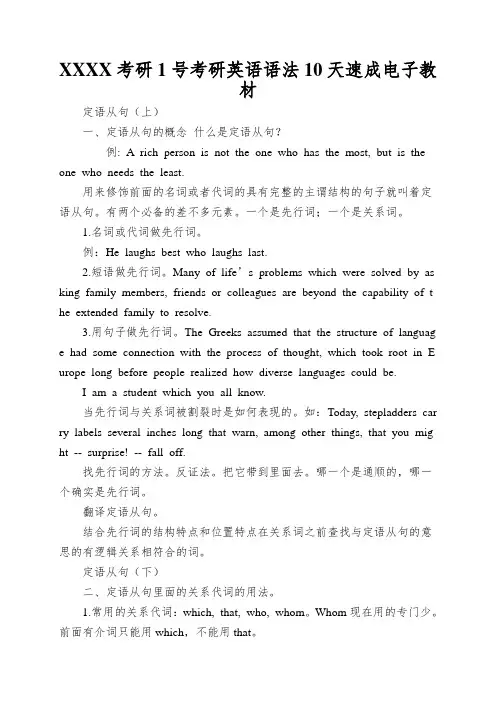
XXXX考研1号考研英语语法10天速成电子教材定语从句(上)一、定语从句的概念什么是定语从句?例: A rich person is not the one who has the most, but is the one who needs the least.用来修饰前面的名词或者代词的具有完整的主谓结构的句子就叫着定语从句。
有两个必备的差不多元素。
一个是先行词;一个是关系词。
1.名词或代词做先行词。
例:He laughs best who laughs last.2.短语做先行词。
Many of life’s problems which were solved by as king family members, friends or colleagues are beyond the capability of t he extended family to resolve.3.用句子做先行词。
The Greeks assumed that the structure of language had some connection with the process of thought, which took root in E urope long before people realized how diverse languages could be.I am a student which you all know.当先行词与关系词被割裂时是如何表现的。
如:Today, stepladders car ry labels several inches long that warn, among other things, that you mig ht -- surprise! -- fall off.找先行词的方法。
反证法。
把它带到里面去。
哪一个是通顺的,哪一个确实是先行词。

考研英语十二大基础语法体系对于任何英语句子,要分析其结构,这样才能找到英语语言的规律. 每种语言都有它的难点,汉语的难点在于汉语不是拼读语言,汉字很难写,而且有四种声调。
其实,许多接触过多种外语的人都认为,英语的语法比法语、德语、俄语、日语等都简单,是最容易学的。
著名语言学家乔姆斯基说过,语法是内生的、也就是随着语言的诞生而诞生的。
因此,学习语法和学习语言是相辅相成的。
一、英语动词的时态(一)英汉两种语言在时态表达方式上的差异:英语的词类与汉语的不同。
汉语词类形态稳定,比如“书”这个字,“一本书"、“三本书"都一样,没有词形变化。
英语就不同了,book, books仅从词形上就能知道是单数还是复数。
动词是英语中变化最多、最复杂的词类.有人说,学好英语就是学好动词,此言甚是。
同一个动作或状态分别在不同时间发生或存在,表达这个动作或状态的动词就要用不同的形式,这就是时态。
(二)英语动词的形式:英语的时态是通过动词的变化来体现的。
因此,了解动词的形式及其变化规律非常重要。
英语的实义动词有以下五种形式:(1)动词原形:动词原形在句子中形式不变。
主要用于主语为非第三人称单数的一般现在时,情态动词之后,或根据语法规定必须用动词原形的其他情况.(2)一般现在时第三人称单数形式(简称现单三):主要用于主语为第三人称单数的一般现在时。
(3)过去式:主要用于一般过去时。
(4) 现在分词:主要用于进行时态,或语法规定的其他情况.(5)过去分词:主要用于完成时态,或语法规定的其他情况。
动词一般现在时第三人称单数(现单三)的构成,见下表:某些字母组合的不规则动词有一定的规律。
如:weep→wept, sleep→slept, sweep→swept以上每个时间段中分别有四种状态:一般、进行、完成和完成进行。
因此我们便有了四四一十六个时态。
般、进行、完成、完成进行)。
比如在“They are doing their exercises.”这个句子中,动词由原形do 变成are doing 的形态,说明这个事情是发生在现在、并处于正在进行的状态当中,所以叫现在进行时;在“They have done their exercises。

第一编考研必备语法精要速览一、时态、语态时态、语态需要掌握的要点:1.以下几类动词一般不能用于进行时,同样不用于完成进行时:(1)表示感知的动词:hear, feel, notice, recognize, see, taste, smell;(2)表示意愿、情感的动词:desire, dislike, forgive, hate, like, love, prefer, refuse, want, wish, fear, love, hate;(3)表示思考、看法的动词:believe, doubt, expect, forget, hope, feel, mean, know, agree, realize, mind, recall, recollect, remember, trust, suppose;(4)表示所有、占有的动词:belong to, owe, own, possess, hold(容纳);(5)其他动词:cost, appear, concern, contain, consist, deserve, matter, seem。
如:I’d say whenever you are going after something that is belonging to you, anyone who is depriving you of the right to have it is criminal.(1997年考研题,belong表示归属,不用于进行式) He was seeing somebody creeping into the house through the open window last night.(1990年考研题,see表示结果,不用于进行式)2. 不用will/shall表达将来时的形式:(1)be going to表示现在的打算和意图;(2)arrive, come, drive, go, leave, retire, return, set off, start, take off等表示移位的动词的进行体表示按计划肯定要发生的将来动作;(3)be to (do)表示安排、计划、决定、命令或注定要发生的事,如:Greater efforts to increase agricultural production must be made if food shortage is to be avoided.(4)be about to (do)表示将要(做),如:Marlin is a young man of independent thinking who is not about to pay compliments to his political leaders.(5)be on the point /verge of (doing)表示“马上就要”,一般不与表示将来的时间状语连用;(6)be, begin, come, depart, get off, go, leave, return, start的一般现在时表示按日历或时刻表要发生的将来动作或事件,如:If you want your film to be properly processed, you’ll have to wait and pick it up on Friday, which is the day after tomorrow.(画线部分一般不用will be)(7)在时间、条件、让步从句中,一般现在时代替将来时,但要注意区别从句的类型,如:I don’t know where he will go tomorrow. 我不知道他明天去哪儿。
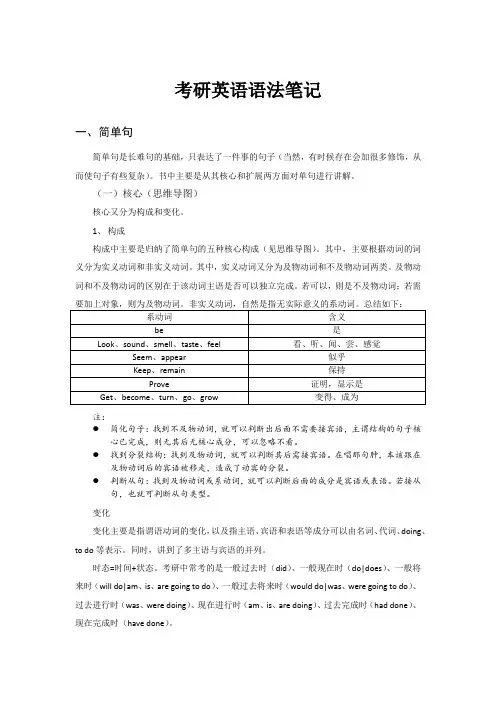
考研英语语法笔记一、简单句简单句是长难句的基础,只表达了一件事的句子(当然,有时候存在会加很多修饰,从而使句子有些复杂)。
书中主要是从其核心和扩展两方面对单句进行讲解。
(一)核心(思维导图)核心又分为构成和变化。
1、构成构成中主要是归纳了简单句的五种核心构成(见思维导图)。
其中,主要根据动词的词义分为实义动词和非实义动词。
其中,实义动词又分为及物动词和不及物动词两类。
及物动词和不及物动词的区别在于该动词主语是否可以独立完成。
若可以,则是不及物动词;若需注:●简化句子:找到不及物动词,就可以判断出后面不需要接宾语,主谓结构的句子核心已完成,则无其后无核心成分,可以忽略不看。
●找到分裂结构:找到及物动词,就可以判断其后需接宾语。
在唱那句肿,本该跟在及物动词后的宾语被移走,造成了动宾的分裂。
●判断从句:找到及物动词或系动词,就可以判断后面的成分是宾语或表语。
若接从句,也就可判断从句类型。
变化变化主要是指谓语动词的变化,以及指主语、宾语和表语等成分可以由名词、代词、doing、to do等表示。
同时,讲到了多主语与宾语的并列。
时态=时间+状态。
考研中常考的是一般过去时(did)、一般现在时(do|does)、一般将来时(will do|am、is、are going to do)、一般过去将来时(would do|was、were going to do)、过去进行时(was、were doing)、现在进行时(am、is、are doing)、过去完成时(had done)、现在完成时(have done)。
情态动词有两种用法:1、表达“情绪和态度”;2、表达“推测”。
常见的情态动词:must、can、could、will、would、should、may、might。
情态动词+动词原形,算是一个整体。
语态就被动与主动之分,被动的时候就是be+done。
否定时,实义动词变否定,前加助动词(do|does|did),再加not,最后加动词原形即可。
⼗天搞定考研词汇(摘⾃《2008考研英语⾼分写作》,王江涛编著,群⾔出版社)(⼀)总论对绝⼤多数中国同学来说,学英语就是背单词,单词是很多同学⼼中永远的痛。
词汇是写作的基⽯,要想取得写作⾼分,必须突破词汇。
但很多同学却陷⼊了背单词的误区。
有些同学喜欢抱着厚厚的词汇书背,企图⼀⽓呵成,结果⼀天背⼏⼗个就晕过去了。
有些同学喜欢拼写,每个单词都要写上⼏⼗遍,可往往写到第⼗遍的时候就已经丢了⼀个字母,结果变成不断强化⾃⼰的错误记忆。
还有的同学喜欢边拼边读,我曾见过⼀位同学把某⼀单词刻苦拼读了四五⼗次。
当她写了五⼗多次后,我问她这个词什么意思。
这位同学茫然地看了我⼀眼,重复了两遍读⾳,说忘了。
由此可见,机械惯性重复并不能达到真正的记忆。
科学的单词记忆⽅法应该分成三步:第⼀是快速突破,第⼆是详细了解,第三是实战运⽤。
上⽂已提到,真正运⽤于写作的单词不过2000余个。
绝⼤部分考研词汇并不需要掌握拼写和发⾳,只要“见其形,知其义”即可。
快速突破这些写作单词后,再找⼀本⽐较详细的词汇书或字典,了解其的英⽂解释、同义词、反义词、⽤法等,但并不需要全背下来。
最后就是在练习中体会单词在上下⽂中的具体⽤法。
(⼆)记忆秘笈很多同学平时词汇书背得很熟,上了考场却有如下⼏种反应:(1)这个词我背过;(2)我知道这个词在词汇书第⼏页;(3)这个词上⾯和下⾯的词我都记得;(4)我忘了这个词什么意思了。
笔者以前也有过这样的感觉,原因在于只按照⼀种顺序背单词。
背单词应该按照三种顺序:正序记忆、逆序记忆和乱序记忆。
绝⼤部分词汇书是按正序(即字母A~Z的顺序)编排的。
很多同学背A时信⼼百倍,背B时备受打击,背C时彻底崩溃,因此出现了很多C先⽣、D⼩姐。
书的A到C部分已经翻⿊、翻烂了,⽽Z那个部分还从来没看过。
显然,这样是不⾏的。
第⼀遍背单词可以正序记忆,从第⼀页看到第⼗页。
第⼆遍背单词应该采⽤逆序记忆,从第⼗页最后⼀个单词倒着往前背。
从第三遍开始进⾏乱序记忆,从第五、⼋页等开始,先往前背,后往后背,这样才能建⽴对应关系,彻底记住单词。
考研1号考研英语语法10天速成电子教材定语从句(上)一、定语从句的概念什么是定语从句?例: Arich personisnottheone whohasthe most, butis the onewhoneeds theleast.用来修饰前面的名词或者代词的具有完整的主谓结构的句子就叫着定语从句。
有两个必备的基本元素。
一个是先行词;一个是关系词。
1.名词或代词做先行词。
例:He laughs best who laughs last.2.短语做先行词。
Many of life’s problemswhich were solved by askingfamily members, friendsor colleaguesare beyond thecapability ofthe extend ed family toresolve.3.用句子做先行词。
The Greeksassumedthatthe structureoflanguagehadsome connection withtheprocess of thought, whichtookroot in Europelongbefore people realized how diverse languages could be.I am a student whichyou all know.当先行词与关系词被割裂时是如何表现的。
如:Today,stepladders carrylabels several inches long thatwarn, among other things,that youmight--surprise!-- fall off.找先行词的方法。
反证法。
把它带进去。
哪一个是通顺的,哪一个就是先行词。
1.翻译定语从句。
2.结合先行词的结构特点和位置特征在关系词之前寻找与定语从句的意思的有逻辑关系相符合的词。
10天语法速成讲义考研语法10天速成电子教材主讲:印建坤欢送使用新东方在线电子教材定语从句〔上〕一、定语从句的概念什么是定语从句?例: A rich person is not the one who has the most, but is the one who needs the least.用来修饰前面的名词或者代词的具有完整的主谓结构的句子就叫着定语从句。
有两个必备的根本元素。
一个是先行词;一个是关系词。
1.名词或代词做先行词。
例:He laughs best who laughs last.2.短语做先行词。
Many of life’s problems which were solved by asking family members, friends or colleagues are beyond the capability of the extended family to resolve.3.用句子做先行词。
The Greeks assumed that the structure of language had some connection with the process of thought, which took root in Europe long before people realized how diverse languages could be.I am a student which you all know.领先行词与关系词被割裂时是如何表现的。
如:Today, stepladders carry labels several inches long that warn, among other things, that you might -- surprise! -- fall off.找先行词的方法。
反证法。
把它带进去。
哪一个是通顺的,哪一个就是先行词。
1.时间名词前所用介词的速记歌:年月周前要用in,日子前面却不行遇到几号要用on,上午下午又是in要说某日上下午,用on换in才能行午夜黄昏须用at, 黎明用她也不错At也用在明分前,说差可要用上to说过只可使用past,多说多练牢牢记莫让岁月空蹉跎2.非谓语动词的一些特殊用法:后只接不定式作宾语的一些常用特殊谓语动词动词后,不定式,Want, hope, wish, agree, decide, Manage, promise, expect, pretend,且说两位算在此,要记牢,要记住掌握它们靠自己3.后只接动名词做宾语的一些常用特殊动词特殊动词接动名,使用它们要记清放弃享受可后悔,坚持练习必完成延期避免非介意,掌握它们今必行4.后接动词不定式做宾语补足语,省略不定式符号to的一些常用特殊动词:一些动词要掌握,have, let和make, 此三动词是使役,注意观察听到see, 还有feel和watch,使用它们要仔细,后接宾补略去to, 此点千万要牢记除此之外,还可掌握八字言一感feel, 二听hear, listen to, 三让have, let, make, 四看see, Look at, observe, watch5.动名词在句中的功能及其它动名语法其功能,名词特征有动形主宾表定都可作,动名现分要认清现分不作宾和主,动名作状可不行二词皆可作定语,混为一谈不允许,主谓关系视分词,动名一词无此义。
6.现在分词形式及在句子中的作用(包括过去分词的作用)现在分词真好记,动词后面ing它的作用真不小,可以充当定状表还有宾语补足语,忘记此项不可以7.分词做定语的位置及其他:定分位置有二条,词前词后定分晓单个分词在词前,有时此规有颠倒分词短语在词后,定从和它互对照现分动作进行时,过分动作完成了(注:定分:做定语的分词;定从:定语从句;现分:现在分词;过分:过去分词)8.分词做状语在句中所表示的意义:分词做状语,概有七意义时间和原因,结果与目的方式加伴随,条件常出席且谈其主语,谓语头前的*。
标题:11页纸吃透全部英语语法体系笔记一、前言在学习英语的过程中,语法是一个非常重要的部分。
掌握好英语的语法体系,能够帮助我们更好地理解和运用英语,提高我们的语言表达能力。
制作一份详细的英语语法笔记对于我们学习英语非常重要。
二、目的1.帮助自己理清英语语法的体系结构,全面掌握各种语法知识;2.为查漏补缺提供便利,将学过的知识都整理出来;3.为日后复习和总结打下坚实的基础。
三、方法1.分模块学习,将英语语法知识按照不同的类型进行整理;2.使用11页纸,将笔记内容写得尽量详细,包括规则、例句、练习题等;3.在复习的时候,可以通过查阅笔记来进行系统性的复习。
四、笔记内容1.名词-名词的定义及分类-名词所有格的用法-可数名词和不可数名词的区分-名词的单数变复数规则-名词的复数形式-名词的所有格形式-名词的特殊用法-名词的用法举例2.代词-人称代词的用法-物主代词的用法-指示代词的用法-疑问代词的用法-不定代词的用法-相互代词的用法-反身代词的用法-关系代词的用法-连接代词的用法-代词的用法举例3.动词-动词的时态a. 一般现在时b. 一般过去时c. 一般将来时-动词的语态-动词的情态-动词的语气-动词的形式-动词短语及动词词组-动词的用法举例4.形容词和副词-形容词的用法-副词的用法-形容词和副词的比较级和最高级-形容词和副词的原级、比较级和最高级的变形规则-形容词和副词的位置-形容词和副词的用法举例5.介词-介词的定义-介词短语的构成-介词短语的用法-介词的位置-介词的用法举例6.连词-连词的分类-并列连词的用法-从属连词的用法-连接副词的用法-连接代词的用法-连词的用法举例7.形容词从句和副词从句-形容词从句的引导词-形容词从句的位置-形容词从句的用法-形容词从句的结构-形容词从句的举例-副词从句的引导词-副词从句的位置-副词从句的用法-副词从句的结构-副词从句的举例8.倒装句-倒装句的结构-倒装句的用法-倒装句的举例9.虚拟语气-虚拟语气的概念-虚拟语气的形式-虚拟语气的结构-虚拟语气的用法-虚拟语气的举例10.句子成分及句型-主谓宾定表补-复合句的结构-主谓状宾补-状语从句的用法-名词性从句的用法-定语从句的用法11.语态转换-主动语态和被动语态的构成-主动语态和被动语态的用法-主动语态和被动语态的区分-主动语态和被动语态的举例五、总结通过制作11页纸的英语语法笔记,我不仅加深了对英语语法的理解,还锻炼了自己的整理归纳能力。
英语语法笔记大全英语语法笔记大全1. 词类(Parts of Speech)- 名词(Nouns)- 代词(Pronouns)- 形容词(Adjectives)- 动词(Verbs)- 副词(Adverbs)- 介词(Prepositions)- 连词(Conjunctions)- 冠词(Articles)2. 句子结构(Sentence Structure)- 主语和谓语(Subject and Predicate)- 直接宾语和间接宾语(Direct and Indirect Objects) - 定语和状语(Adjectives and Adverbs)- 主谓一致(Subject-Verb Agreement)- 句子类型(Sentence Types)3. 时态和语态(Tenses and Voices)- 简单时态(Simple Tenses)- 完成时态(Perfect Tenses)- 进行时态(Progressive Tenses)- 将来时态(Future Tenses)- 被动语态(Passive Voice)4. 句子成分(Sentence Elements)- 主语(Subject)- 谓语(Predicate)- 宾语(Object)- 补语(Complement)- 状语(Adverbial)5. 修饰语(Modifiers)- 限定词(Determiners)- 修饰词(Modifiers)6. 从句(Clauses)- 名词性从句(Noun Clauses)- 定语从句(Adjective Clauses)- 副词从句(Adverbial Clauses)7. 并列句(Compound Sentences)- 并列连词(Coordinating Conjunctions)8. 复合句(Complex Sentences)- 主从连词(Subordinating Conjunctions)9. 标点符号(Punctuation)- 句号(Period)- 逗号(Comma)- 隔句号(Semicolon)- 问号(Question Mark)- 感叹号(Exclamation Mark)- 引号(Quotation Marks)- 冒号(Colon)- 括号(Parentheses)以上是英语语法的主要内容,通过系统地学习和掌握这些知识点,可以帮助提高英语写作和口语的准确性和流畅性。
考研英语语法十天速成超详细笔记考研英语语法10天速成一.情态动词的现在完成式的用法情态动词现在完成式主要有两个功能:表示已经发生的情况和表示虚拟语气。
在这两个方面must/mustn't,; can/cann't; need/needn't; may/mayn't; might/mightn't; should/shouldn't; ought等情态动词+完成式表示的意思是有一定区别的1.表示已经发生的情况。
1) must have+过去分词,表示对已发生情况的肯定推测,译为“(昨天)一定……”。
如:My pain apparent the moment I walked into the room, for the first man I met asked sympathetically:” Are you feeling all right?”A. must beB. had beenC. must have beenD. had to be(答案为C.2) can't / couldn't have+过去分词,表示对已发生情况的否定推测,译为“(昨天)一定没……”。
如:Mary my letter; otherwise she would have replied before now.A. couldn't have receivedB. ought to have receivedC. has receivedD. shouldn't have received(答案为A.3) may / might have +过去分词,表示对已发生的事情做不肯定、可能性很小的推测,或事实上根本没发生,译为“也许……”。
如:At Florida Power's Crystal River plant, a potentially serious leakage of radioactive water may have been unknowingly caused by an electrician.2.表示虚拟语气。
1) needn't have +过去分词,表示做了不必做的事,相当于”didn't need to do”,译为“其实没必要……”。
如:You needn't have come over yourself.As it turned out to be a small house party, we so formally.A. needn't dress upB.did not need have dressed upC. did not need dress upD. needn't have dressed up(没有必要穿的那么正式,体现是说话者的建议,实际结果是否真的穿的很正式没有确定,答案为D.2) should have +过去分词,表示应该做某事但实际上未做,译为“本应该……”should not + h ave过去分词表示本不应该做某事但实际上做了,译为“本不应该……”。
如:I regret having left the work unfinished; I should have planned everything ahead carefully.我本来应该事先认真地把每件事情规划的很好,但实际上作者还是没有规划好,以至工作没有完成。
3) ought to have +过去分词,表示动作按理该发生了,但实际上未发生,译为“该……”,与should的完成式含义类似。
如:The porter ought to have called the fire-brigade as soon as he saw the fire in the stock, which went up in smoke.4) could have +过去分词,表示过去本来可以做但却未做,译为“完全可以……”。
这点与ought/should/ have +过去分词用法相似。
如:What you said is right, but you could have phrased it more tactfully.5) may/ might have +过去分词,表示过去可以做但实际未做,译为“(那样)也许会……”。
如:It might have been better to include more punchy statistics and photos of equipment in the introduction to further assist first-time office automation managers.二.几个情态动词常考的句型:1). may/might (just) as well “不妨,最好”,与had better相近;Since the flight was cancelled, you might as well go by train.既然航班已经取消了,你不妨乘火车吧。
相当于you had better go by train。
2). cannot / can't…too …“越……越好,怎么也不过分”。
注意这个句型的变体cannot…over….如:Thackeray's.3)比较级与倍数词关系及其位置原级结构中可插入表达倍数的词,表示为“为….若干倍”,当与有表示倍数比较的词在一起时候等,他们的位置是,倍数词+as…as…,或倍数词+more…than…,但again一般放在原级词之后,即“as+原级+again+as”.如:Smoking is so harmful to personal health that it kills people each year than automobile accidents.A. seven more timesB. seven times moreC. over seven timesD. seven times(答案为B.“Do you regret paying five hundred dollars for the painting?”“No, I would gladly have paid for it.”A. twice so muchB. twice as muchC. as much twiceD. so much twice(答案为B.My uncle is as old again as I am4)下列词和短语不用比较级形式却表示比较概念:inferior, minor, senior, prior, prefer to, superior, major, junior, preferable, differ from, compared with, in comparison with, different from, rather than.如:Their watch is to all the other watches on the market.A. superiorB. advantageousC. superD. beneficial(答案为A.Prior to his departure, he addressed a letter to his daughter. (1986年考研题)5)“比较级+and +比较级”或“more and more/less and less +原级”以及“ever, steadily, daily等副词+比较级”结构表示“越来越……”的意思,与这类结构搭配的常用动词有grow, get, become等。
前面两种情况更多地出现在进行时态中,注意的是这三种情况引导的比较级后面都不需要用than.如:Things are getting worse and worse.As I spoke to him he became less and less angry.Her health was becoming daily worseThe road got ever worse until there was no road at all = the road got worse and worse.6)比较级前面可以用even, still, yet, all the (more)等修饰语用以加强语气,表示“更加”的意思。
如Today it is even colder than yesterdayI have yet more exciting news for you7)有关比较级的特殊句型:A.: not so much…as…与其说……不如说……The chief reason for the population growth isn't so much a rise in birth rates a fall in death rates as a result of improvements in medical care.A. andB. asC.butD. or人口增长的主要原因与其说是因为出生率的提高,还不如说是因为医疗的进步带来的死亡率下降的结果。
答案为BB. no/not any more…than…两者一样都不……The heart is intelligent than the stomach, for they are both controlled by the brain.A. not soB.not muchC.much moreD. no more(心脏和胃两者都不具有智力,他们都受大脑控制。
答案为D.There is no reason they should limit how much vitamin you take, they can limit how much water you drink.A. much more thanB. no more thanC. no less thanD. any more than(答案为D.C. no/not any less…than…两者一样,都……注意基本上与no/not any more…than意思相反She is no less beautiful than her sister.她和她姐姐一样漂亮D. just as… so…正如……,……也……(用倒装结构)Just as the soil is a part of the earth, the atmosphere.A. as it isB. the same isC. so isD. and so is(答案为C.2.最高级形式应注意的问题:1)最高级比较范围用介词in, over, of, among。